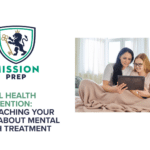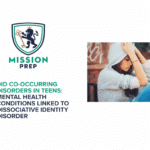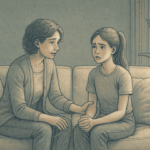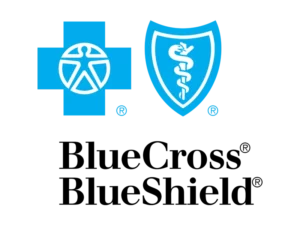How to Support a Teen with Co-Occurring Disorders

Understanding co-occurring disorders in teens can feel like trying to answer the question “Which came first: the chicken or the egg?” In other words, did your child’s mental health issue lead to a substance abuse problem, or did the substance cause mental health symptoms?
Up to 45% of young people with a mental health condition have co-occurring substance use issues. You may also come across the terms “comorbid diagnosis” or “dual diagnosis” when learning about the problem.1
Truthfully, coping with a mental health condition is frightening enough by itself. Yet, supporting a teen with co-occurring disorders and substance abuse issues can bring an even wider range of challenges. You don’t have to deal with this alone.
The good news is that both mental health conditions and substance use problems are treatable. A mental health professional can look beyond a diagnosis and help teens and families understand the root causes of issues and develop brighter avenues for the future. This article can also help by breaking down:
- What co-occurring disorders in teens are
- How to identify co-occurring mental health conditions
- How co-occurring disorders impact adolescence
- Ways to support a teen with mental health and substance use issues
- How to find therapy for co-occurring disorders
- Where to find support for a teen with mental health and substance abuse issues

Understanding Co-Occurring Disorders in Teens
If your child has a dual diagnosis for a mental health condition and substance use disorder, you may feel very alone. Like what’s happening is unusual or rare. Yet, many teenagers who develop a mental health condition also form a substance use disorder – and vice versa.2
For instance, studies show that there’s a high rate of crossover between anxiety disorders, such as post-traumatic stress disorder (PTSD) and panic disorder, with substance use. The reasons why these issues tend to go hand in hand can go two ways.
Firstly, coping with mental health issues such as anxiety or depression can be highly difficult, as they can cause deep emotional pain, low self-worth, and lack of sleep. Therefore, studies show that when a teen has issues such as these, they may try to self-medicate using a substance.3
Secondly, substance use can increase a teen’s risk of developing a mental health condition. For instance, marijuana use has been linked to higher rates of psychosis, especially in families who have a history of these disorders.1
However, even though the relationship between substance use and mental health conditions can go two ways, this doesn’t necessarily mean that one causes the other. In fact, evidence suggests that there may be genetic risk factors for both conditions; substance use and mental health issues run in families. For instance, trauma can be passed down through certain genes and leave a teen predisposed to both conditions. However, the specific genes responsible for this are not yet understood.3
If you’re concerned that your child has a co-occurring mental health and substance use disorder, it can help to understand the signs.
Identifying Co-Occurring Mental Health Conditions
The signs and symptoms of co-occurring disorders can depend on the mental health condition and the substance used. For instance, substances such as stimulants can cause irritability, weight loss, and sleep loss. On the other hand, opioids can lead to a lack of interest and energy, euphoria, and drowsiness.
A mental health professional can help parents understand the symptoms of co-occurring disorders based on certain mental health conditions and substances, but we’ll cover some of the signs here.
Co-Occurring Anxiety and Substance Use in Teens
The symptoms of anxiety in teens include:
- Nervousness, tension, and restlessness
- A sense of impending danger
- Worries about the past, present, and future
- Tiredness
- Difficulty concentrating
- Physical pains, such as stomachaches
- Avoidance of situations that cause worry
- Engaging in risky behaviors
If your child has anxiety and is also using a substance, you may notice a shift in their regular behaviors. This shift may depend on the substance, but it could look like drowsiness, reduced nervousness, slurred speech, lack of coordination, sleeping more or less, and changes in mood. In other words, if your child has anxiety and has been self-medicating, you may notice out-of-the-ordinary behavior and mood changes. A mental health professional can help with managing anxiety and addiction in teenagers, so it’s important not to wait to seek support.4
Co-Occurring Depression and Substance Use in Teens
The symptoms of depression in teens include:
- A persistent low or depressed mood
- Loss of pleasure or interest in activities
- Changes to weight, such as loss or gain
- Trouble sleeping or sleeping too much
- Tiredness and exhaustion
- Feelings of guilt or worthlessness
- Problems thinking or concentration
- Engaging in risky behaviors
Similar to teenagers with anxiety, teens with depression may also have a higher risk of using substances to self-medicate. Again, the signs of depression and substance use in teens may also depend on the substance, but it can help to look out for signs of out-of-the-ordinary behavioral or physical changes. For example, they may have dilated pupils, slurred speech, or lack of coordination. Additionally, mood changes caused by substances may include paranoia or erratic behavior.5
The longer mental health conditions are left untreated, a teen is left at a greater risk of turning to substances to cope. Mission Prep can offer parental guidance for co-occurring disorders, so don’t hesitate to reach out.
How Co-Occurring Disorders Impact Adolescence
Substances affect teenagers differently from adults. Teens’ brains aren’t fully developed yet, so early substance use can lead to an increased risk of addiction, impulsive behaviors, emotional control difficulties, and physically risky actions.6
For example, when an adult drinks alcohol, they might become more relaxed and easy-going. In contrast, when a teenager drinks, they might have an increase in energy, make poor decisions, and even become aggressive.
The risks of these physical and emotional changes can depend on a teen’s mental health condition; for instance, if they have depression, thoughts of suicide might increase. Just because a teenager tries to mask their depression with a substance doesn’t mean it disappears – it’s still there. However, the ability to control their emotions and impulses is reduced while under the influence, so they might pose greater harm to their own well-being.
Plus, while self-medicating might help a teen to feel better temporarily, these effects don’t last. When the substance wears off, their difficult emotions return – but this time with added “hangxiety.” Their brains, which already struggle to produce “happy hormones,” are now at even more of a disadvantage. So, in order to feel good again, they might reuse, potentially leading to physical and emotional dependence.7
Supporting a teen With Mental Health and Substance Use Issues
Parents and families play a crucial role in supporting a teen with mental health and substance use issues. However, you don’t have to cope with the problem alone – and nor should you. Comorbid mental health and substance use issues can seriously damage a teen’s emotional and physical health, as well as prospects for the future. Professional support is advised for helping a teen struggling with mental health and addiction.
However, families can support a teen during treatment in the following ways.1
Learn About What Your Child Is Going Through
Understanding co-occurring disorders in teens means learning about their mental health condition and substance use problem, as well as the effects of medications and warning signs of relapse. A mental health professional can talk you through each of these points, but governmental resources such as the National Institute of Mental Health can also help.
Attend Family Therapy for Co-Occurring Disorders
Being actively involved in your child’s mental health not only increases the chance that they’ll be willing to accept therapy, but it can also improve the outcomes of treatment. Moreover, family engagement can boost the family bond, helping a teen feel supported every step of the way.8Help in Practical Ways
Supporting a teen with mental health and substance use issues doesn’t just mean being involved in therapy. You can also help them in practical ways, such as helping them manage medication (including side effects), making therapy appointments, and advocating for their rights in treatment.
Maintain a Routine
Dual diagnosis treatment for adolescents can make them feel like their lives are out of their control. A regular routine can give your child a much-needed sense of stability and predictability. For instance, create a daily sleeping, waking, eating, and exercising structure to help them stay focused and motivated.
Join a Family Support Group
Family support groups can help you better understand your child’s dual diagnosis and how to cope in healthy ways. They also provide empathetic and listening ears for whatever you might be going through as a parent. Mission Prep offers a variety of family support groups, including what to expect from treatment and how to be involved.
How to Find Therapy for Co-Occurring Disorders
If your child has co-occurring mental health and substance abuse issues, you might feel like you’re lost in the woods at night without a compass. You might wonder whether it’s best to focus on their mental health first or target their substance use. Or you might be feeling overwhelmed by the different forms of therapy available and which ones are right for your child.
You don’t have to find your way out of the woods by yourself. Mission Prep can act as your compass. We can talk to you about the option of residential treatment for your child’s needs, or discuss whether intensive outpatient treatment is a more suitable option. Teen rehab for mental health treatment is not a one-size-fits-all approach, so we can explain the following therapy options and how they can work for your teen.
Best Treatment Options for Dual Diagnosis Teens
- Cognitive behavioral therapy (CBT): CBT is a first-line form of behavioral therapy for dual diagnosis teens, as it has proven to be effective in treating a variety of mental health conditions and substance use disorders. It works by targeting teens’ thoughts and actions, helping them identify negative patterns and build healthy ways of coping. Trauma-focused CBT can also help a teen get to the root of their problems
- Eye Movement Desensitization and Reprocessing (EMDR): Both substance use and mental health conditions can stem from problematic previous experiences, such as trauma. EMDR is an effective way of treating trauma as it changes how these memories are stored in the brain, helping a teen move past trauma and form more positive beliefs.
- Transcranial Magnetic Stimulation: TMS can be effective in treating treatment-resistant mental health conditions. It’s a non-invasive therapy that uses magnetic fields to activate nerve cells in targeted areas of the brain – improving outlook and mood. It has even been shown to reduce substance cravings in a teen, limiting the risk of relapse.9
- Family therapy for co-occurring disorders: Family can be protective of a teen’s mental health. For this reason, family involvement in therapy can improve a teen’s symptoms, especially if there are relationship dynamics that are contributing to mental health and substance difficulties. For instance, interpersonal therapy can highlight issues in relationships, help teens and families work through them, and figure out better ways of coping.
- Group therapy: Teenagers can learn how they use substances to cope with mental health issues by interacting with peers. These groups can help a teen feel better understood and also develop healthier ways of coping with their issues.

Reach Out for Help With Supporting a Teen With Mental Health and Substance Use Issues
Mission Prep sees beyond diagnoses to the person behind them. If you’re concerned about dual diagnosis treatment for adolescents, rest assured that we will treat a teen and their family with care, consideration, and empathy.
We provide behavioral therapy for dual diagnosis teens in our residential centers in California and Virginia, and will tailor our treatments to a child’s and family’s needs. For instance, if telehealth services are more appropriate for your schedule, we can work with your family to arrange a suitable outpatient program. Aside from therapy, we can also provide medication management for dual diagnosis teens.
Helping a teen struggling with mental health and addiction isn’t always straightforward. Long-term care for teens with co-occurring disorders means continuously assessing a teen’s symptoms and needs, and adapting treatment protocols as necessary – including education about the risk and warning signs of relapse. Mission Prep guides teens and their families through every stage of this process, listening to their opinions at each step. If you’re ready to take the first step to protect your child’s well-being – or even if you have any questions about what we offer – reach out to our team today.
References
- Bradley Hospital. (n.d.). Guide to co-occurring disorders in adolescents. Lifespan. Retrieved April 26, 2025, from https://www.lifespan.org/centers-services/co-occurring-disorders-services-bradley-hospital/guide-co-occurring-disorders
- National Institute on Drug Abuse. (2020). Common comorbidities with substance use disorders research report. National Institutes of Health. https://www.ncbi.nlm.nih.gov/books/NBK571451/
- National Institute of Mental Health. (n.d.). Substance use and mental health. U.S. Department of Health and Human Services, National Institutes of Health. Retrieved April 26, 2025, from https://www.nimh.nih.gov/health/topics/substance-use-and-mental-health
- Back, S. E., & Brady, K. T. (2008). Anxiety Disorders with Comorbid Substance Use Disorders: Diagnostic and Treatment Considerations. Psychiatric Annals, 38(11), 724. https://doi.org/10.3928/00485713-20081101-01
- Marino, E. N., Jha, M. K., Minhajuddin, A., Ayvaci, E. R., Levinson, S., Pipes, R., Emslie, G. J., & Trivedi, M. H. (2024). Problematic substance use in depressed adolescents: Prevalence and clinical correlates. Addictive Behaviors Reports, 19, 100539. https://doi.org/10.1016/j.abrep.2024.100539
- Miller, C. (2024, June 5). Mental health disorders and teen substance use. Child Mind Institute. https://childmind.org/article/mental-health-disorders-and-substance-use/
- National Institute on Alcohol Abuse and Alcoholism. (n.d.). Alcohol and the adolescent brain. U.S. Department of Health and Human Services. https://www.niaaa.nih.gov/publications/alcohol-and-adolescent-brain
- Berry, K. R., Gliske, K., Schmidt, C., Ballard, J., Killian, M., & Fenkel, C. (2023). The Impact of Family Therapy Participation on Youths and Young Adult Engagement and Retention in a Telehealth Intensive Outpatient Program: Quality Improvement Analysis. JMIR Formative Research, 7, e45305. https://doi.org/10.2196/45305
- Gorelick, D. A., Zangen, A., & George, M. S. (2014). Transcranial magnetic stimulation (TMS) in the treatment of substance addiction. Annals of the New York Academy of Sciences, 1327(1), 79. https://doi.org/10.1111/nyas.12479



















